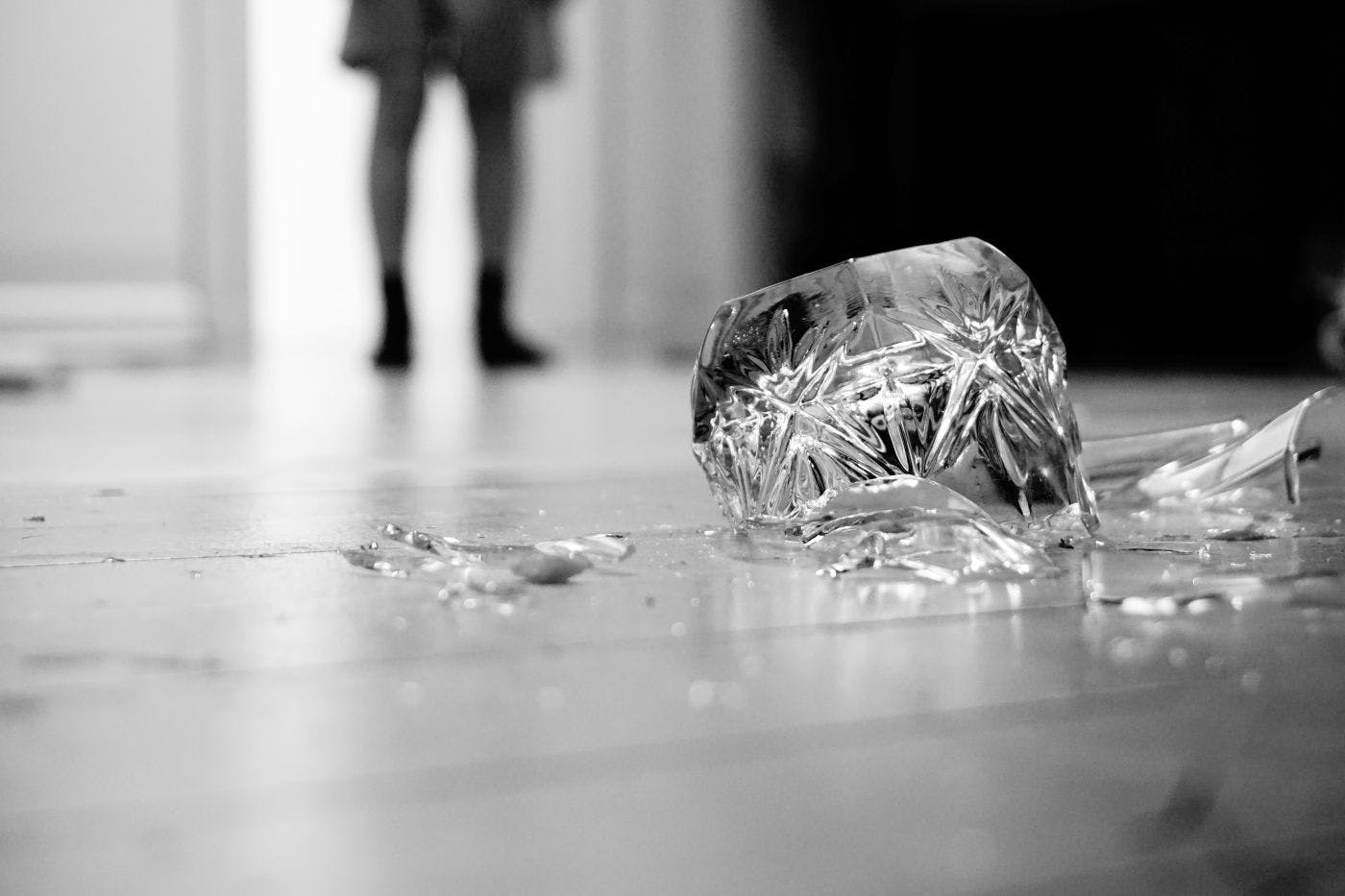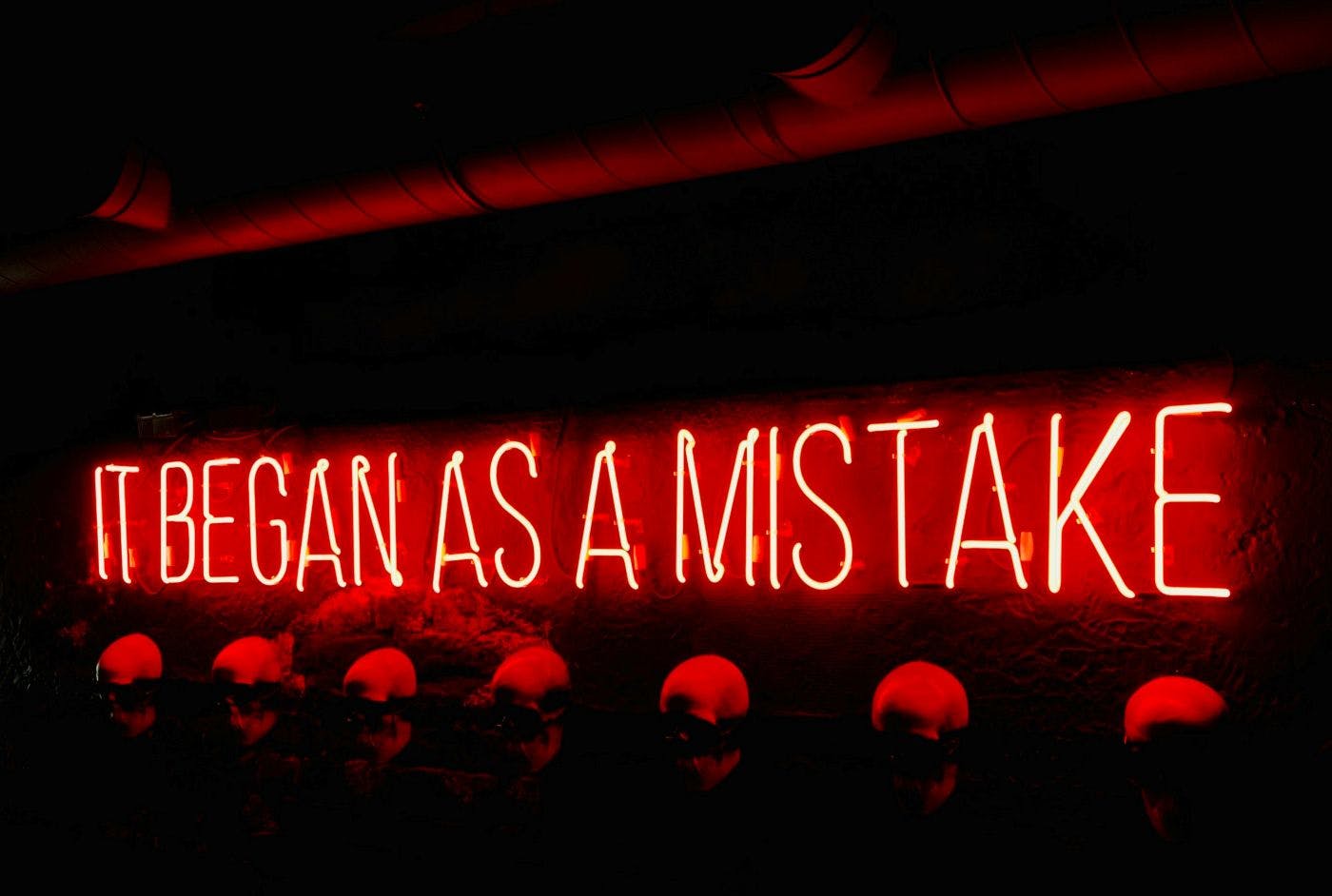

Do brands make mistakes? Absolutely. The stakes might be higher and the spotlight brighter, but a brand slip-up is really just a collective version of the mistakes we all make as individuals.
You must have made a mistake so crazy that you had no idea how you could have possibly done it? I have. And I did it recently.
Without going into too much detail (and boring you to tears), I made a doozy of a mistake. Now I’m working hard to recover from it—assuring my boss it will never happen again, and assuring a client that I wasn’t actually on crack when I sent such material, and would never normally send anything like that. I got a stern talking-to from my boss, and it seems okay now: the apology was accepted, and systems are in place to keep that kind of mistake from happening again. All is well. But I don’t feel well.
Maybe it’s perfectionism. Maybe it’s just fear of losing my job. But I hate making mistakes, and I tend to beat the hell out of myself when I make one. I have a hard time shaking it off—no matter what Taylor Swift advises—and I can’t seem to get my mind back to a neutral, calm place. I’m sure I’m not alone. Still, it triggers my imposter syndrome and leaves me useless for a while, brutalizing myself over it.
This got me thinking. None of us is perfect, and mistakes are inevitable. Some people say, “Meh, I’ll do better next time.” Others—like me—let mistakes fester until we’re supine in an Irish pub, weeping into someone’s boots about how pathetic we are.
Which made me wonder: what about brands? Do brands make mistakes? Do they wallow, or do they shake it off and keep going? How do they even know when they’ve made a mistake?
As I wallow and abuse, I think this is a good topic of discussion. So, here we go.
A Pivot to Brands
As I sat there beating myself up, it struck me: if I’m this rattled by one mistake, what about brands? After all, brands are made up of people, processes, and decisions — and those go wrong sometimes.
Do brands make mistakes? Absolutely. The stakes might be higher and the spotlight brighter, but a brand slip-up is really just a collective version of the mistakes we all make as individuals. The interesting question isn’t whether mistakes happen (because they do) but how brands react afterward.
Do they wallow in shame and retreat, too afraid to move forward? Do they shrug it off too quickly, hoping no one noticed? Or do they face the mistake head-on, learn from it, and keep moving?
And perhaps the most critical question: how does a brand even know it has made a mistake? Sometimes it’s obvious — a campaign lands with a thud, customers revolt, or headlines start screaming. Other times, it’s more subtle — a quiet drop in trust, a fading sense of relevance, a shift in customer sentiment that only shows up in hindsight.
What I realized is this: brands, like people, don’t get to choose whether mistakes happen. They only get to choose how they respond.

What Counts as a Brand Mistake?
When we talk about “mistakes,” it’s tempting to think only of the spectacular, headline-grabbing disasters — the kind of brand implosions that get dissected on Twitter and in marketing classrooms for years. But brand mistakes exist on a spectrum, just like personal ones.
On one end, there are the small slips. A typo in an ad. A poorly chosen stock photo. A confusing or inconsistent bit of copy on the website. Think of American Airlines’ ad years ago that ran through translation so poorly it read like nonsense. Harmless? Maybe. But enough small lapses like that chip away at trust. Death by a thousand paper cuts.
Then there are the medium-sized blunders. A social media post that misses the cultural tone. A campaign that feels tone-deaf. Remember Pepsi’s Kendall Jenner ad — where handing a police officer a soda was somehow supposed to solve systemic injustice? Not malicious intent, but a miss so glaring it became a cultural punchline.
And finally, there are the big ones. Product recalls. High-profile lawsuits. Scandals that reveal hypocrisy between what the brand says and what it does. The Volkswagen emissions scandal is the classic case: deliberate deception that went straight to the heart of brand trust.
What makes brand mistakes tricky is that they aren’t always obvious from the inside. A team may think a message is clever, but customers see it as insulting. Leadership may believe a cost-cutting measure is smart, but employees feel betrayed. Sometimes it takes the outside world to hold up the mirror and say, “This isn’t right.”
Brands don’t live in a vacuum. They live in the perceptions of the people who interact with them. And when a mistake happens — small slip or seismic failure — it’s those people who decide whether the brand gets a second chance.
The Immediate Reaction
When I made my mistake, my first reaction wasn’t wisdom or perspective. It was panic. Then came shame, defensiveness, self-criticism, and the overwhelming desire to crawl into a hole. That emotional swing — from “this isn’t a big deal” to “this could end my career” — is exhausting.
Brands often go through the same roller coaster. The first instinct after a mistake is rarely the right one.
- Denial: Pretend nothing happened. Hope no one notices.<br />
- Defensiveness: Double down. Argue the audience “just didn’t get it.”<br />
- Silence: Say nothing, hoping it blows over. Unfortunately, silence reads as indifference or guilt.<br />
- Over-apology: Grovel so excessively the apology itself becomes the headline.<br />
We’ve all seen these plays before. Remember United Airlines initially brushing off the viral video of a passenger being dragged off a plane? Their first statements defended policy and crew actions, which only fanned the outrage. It took days and millions in brand equity lost before they landed on a message that resembled empathy.
Or look at smaller missteps, like when a brand’s social media team posts something insensitive. Some pull it immediately, apologize sincerely, and move on. Others spend days arguing in comments, making the situation worse.
The lesson here is simple, but hard in the moment: the first reaction matters. A brand’s instinct might be to protect itself, but the audience is watching for acknowledgment, clarity, and care. Moving too slowly looks evasive. Moving too fast without thought looks shallow.
Just like people, brands have to resist the urge to flail. The immediate goal isn’t to erase the mistake or wallow in it — it’s to create a foundation for recovery.

The Recovery Process
Once the shock of a mistake has passed, the real work begins. For people, that might mean apologizing, learning, and setting up guardrails to avoid repeating the error. For brands, it’s not so different. The recovery process can be broken into three essential stages: acknowledge, correct, and reconnect.
Step 1: Acknowledge
The first step is the simplest in concept, but the hardest in practice: own the mistake. No spin. No lawyer-approved hedging that says, “We regret if anyone was offended.” That kind of phrasing doesn’t acknowledge the mistake — it shifts the blame to the audience for reacting.
Think of Johnson & Johnson’s Tylenol crisis in the 1980s. When tampered bottles tragically killed consumers, the company didn’t downplay the event or bury the story. They immediately acknowledged the severity, pulled products from shelves nationwide, and spoke directly to the public. That transparency saved their reputation.
Contrast that with Equifax in 2017, when a massive data breach exposed millions of people’s personal information. Their sluggish acknowledgment and confusing communication became part of the scandal itself. The mistake was bad, but the delayed, unclear response made it catastrophic.
Acknowledgment sets the tone. Without it, there’s no path forward.
Step 2: Correct
Words matter, but they only go so far. A brand has to demonstrate how it’s fixing the mistake. That could mean changing internal processes, recalling a product, updating messaging, or even restructuring leadership if the failure is systemic.
Take Toyota’s recall crisis in 2009–2010. Reports of sudden acceleration led to widespread fear. At first, Toyota stumbled with mixed messages. But when they shifted into corrective action — halting sales, issuing recalls, and overhauling safety protocols — they began to rebuild trust. The correction was painful and expensive, but necessary.
Correction is about credibility. A brand that apologizes without action comes across as hollow. Action without apology feels robotic. The two must work together.
Step 3: Reconnect
Finally, after acknowledgment and correction, a brand has to return to its audience with consistency and empathy. This is the long game: rebuilding trust over months and years, not days.
Think of Domino’s Pizza in the late 2000s. After customers complained that their pizza tasted like cardboard, Domino’s didn’t just tweak the recipe quietly. They launched a bold campaign admitting the criticism, showing how they were changing, and inviting customers back to try it. That reconnection strategy turned ridicule into renewed loyalty.
Reconnection doesn’t mean groveling forever. It means proving, again and again, that the mistake was an inflection point — not a permanent definition of the brand.
Mistakes don’t have to be fatal. But recovery isn’t automatic, and it isn’t easy. Brands that walk the path of acknowledge → correct → reconnect give themselves the best shot not just at redemption, but at coming out stronger.
The Psychology of Brands
When I spiral after a mistake, it isn’t really about the mistake itself — it’s about what I believe that mistake says about me. That’s where the self-criticism, the imposter syndrome, and yes, the Irish pub-level wallowing come in. It’s not just “I did something wrong” but “I am something wrong.”
Brands fall into the same trap. They don’t just deal with the event of the mistake — they wrestle with what the mistake says about them in the eyes of the public. That’s why the psychology of mistakes is so important.
Some brands adopt the wallowing mindset. They apologize over and over, sometimes for years, afraid to move forward. Every message they send seems haunted by the shadow of what went wrong. This can lead to paralysis: the brand is so consumed by the fear of repeating the mistake that it loses the courage to innovate.
Other brands lean into the shrug-it-off mindset. They minimize, deflect, or race past the mistake as if nothing happened. The problem here is credibility. If a brand tries to pretend the mistake wasn’t a big deal, audiences feel dismissed. It’s like the friend who hurts your feelings and then says, “Relax, it’s not that serious.” Maybe they move on quickly, but you don’t.
The healthiest brands (like the healthiest people) strike a balanced mindset. They acknowledge the mistake, but don’t let it define them. They take it seriously, but not fatally. They move forward without erasing the past. This balance is what builds long-term resilience.
Consider Apple’s “Antennagate” with the iPhone 4. Users complained that the phone lost signal when held a certain way. At first, Apple seemed dismissive — “you’re holding it wrong.” But when the backlash grew, they shifted: acknowledging the issue, offering free cases, and keeping the conversation light without denying responsibility. The mistake didn’t destroy the brand — it became a blip in an otherwise dominant story. Apple neither wallowed nor shrugged; they adjusted and moved on.
Psychologically, mistakes are identity tests. For a person, it’s the question: Am I still worthy after this? For a brand, it’s: Are we still who we say we are?
The truth is, both people and brands will always slip up. What matters most is whether the mistake becomes the whole story, or just a single chapter. Brands that understand this — that refuse to be defined by their worst moment, but also don’t run from it — are the ones that recover stronger.
So, yes, I may still find myself in an Irish pub on occasion, exaggerating the tragedy of my latest blunder. But brands, thankfully, don’t have that luxury. They can’t lie low with a pint and hope the world forgets. They have to face the music, rewrite the narrative, and prove through consistent action that they’re more than their mistakes.

What Mistakes Can Teach
Here’s the strange gift hidden in mistakes: they hurt, but they teach. Sometimes they’re the only thing that can teach. You can read every leadership book and map out every strategy, but until something goes wrong, you don’t really know where your blind spots are.
For people, mistakes reveal the cracks in our assumptions. Maybe I thought I was careful enough. Maybe I thought my process was airtight. Maybe I thought my judgment was beyond question. Then a mistake crashes through and says, “Think again.” Painful? Yes. Instructive? Absolutely.
Brands are no different. In fact, mistakes are often the clearest signal of where a brand’s systems, culture, or messaging need attention.
1. Mistakes Expose Weak Spots
A product recall might reveal gaps in quality control. A social media backlash might expose the lack of diverse voices in the room. A failed campaign might show that the brand is out of touch with its audience. These are hard truths, but they’re also invaluable insights — insights you don’t get when everything is running smoothly.
Think of Coca-Cola’s “New Coke” debacle in 1985. On paper, the sweeter formula made sense. In reality, customers revolted. Coca-Cola’s mistake revealed the depth of emotional attachment people had to the original product. The company backtracked, but it emerged with a stronger understanding of its core value: tradition and authenticity mattered as much as taste.
2. Mistakes Reveal Relationships
How people react to a mistake tells you how strong (or fragile) your relationship really is. Loyal customers may forgive quickly because the brand has built trust over time. Casual customers may not bother — they’ll just leave.
When Southwest Airlines faced massive flight cancellations in late 2022 due to outdated systems, the chaos tested its reputation. Some travelers swore off the airline forever. But many loyal customers said, “They’ve been good to me for years — they’ll figure this out.” That kind of forgiveness is earned long before the mistake ever happens.
3. Mistakes Build Resilience
The real danger of a mistake isn’t the error itself — it’s failing to learn from it. Brands that use mistakes as feedback loops, as opportunities to strengthen processes and clarify identity, come out more resilient.
Take Domino’s Pizza again. Their “cardboard pizza” moment could have been fatal. Instead, it became the launchpad for reinvention. They didn’t just fix the recipe; they transformed their entire brand story around humility, transparency, and improvement. Today, Domino’s is thriving precisely because it leaned into the lesson.
Mistakes, then, aren’t just crises. They’re curriculum. They force reflection. They expose hidden truths. They teach both the brand and the audience what the brand is really made of.
And yes, the same goes for us as individuals. My recent mistake showed me where my blind spots were, reminded me of my own perfectionism, and forced me to rethink my recovery process. The mistake hurt. But the lesson was worth more than the sting.
Summing Up
When I think back to my own mistake, I’m still not proud of it. I can polish the story now, maybe even joke about Irish pubs and Taylor Swift, but in the moment, it felt awful. And if I’m being honest, it still lingers. That’s the thing about mistakes: they leave echoes.
But here’s what I’ve learned — both as a person and through the lens of brand strategy. Mistakes don’t define you. They reveal you. They’re uncomfortable mirrors that show where you’ve been sloppy, where you’ve been blind, or where you’ve taken trust for granted. They sting, but they sharpen.
The same is true for brands. A mistake can bruise reputation, but it doesn’t have to break it. In fact, when handled with honesty and courage, a mistake can become the very moment that deepens connection with an audience. Customers don’t expect perfection — they expect humanity, accountability, and improvement.
That’s one of the reasons I believe so deeply in the work we do at ThoughtLab. Brand strategy isn’t just about creating glossy campaigns or perfect messaging. It’s about building ecosystems resilient enough to handle the inevitable slip-ups. It’s about preparing brands not for if they’ll make a mistake, but when — and ensuring they have the mindset and systems to respond in a way that strengthens trust instead of destroying it.
So yes, I may still carry a little personal bruise from my recent blunder. But I’m also carrying the lesson forward. And if I can do that — if brands can do that — then mistakes stop being the end of the story. They become the beginning of a stronger one.
